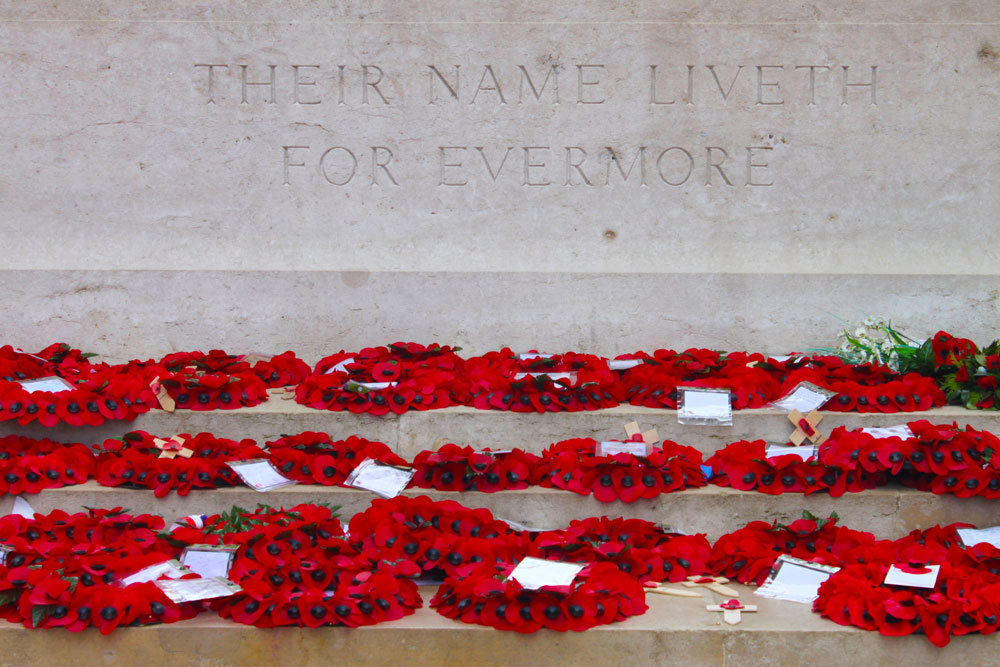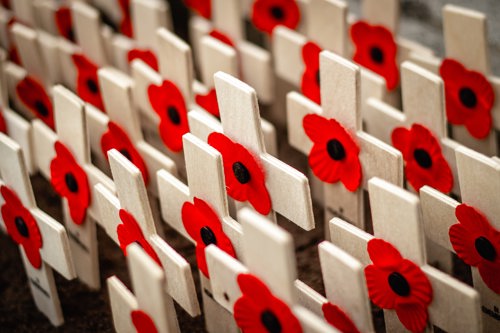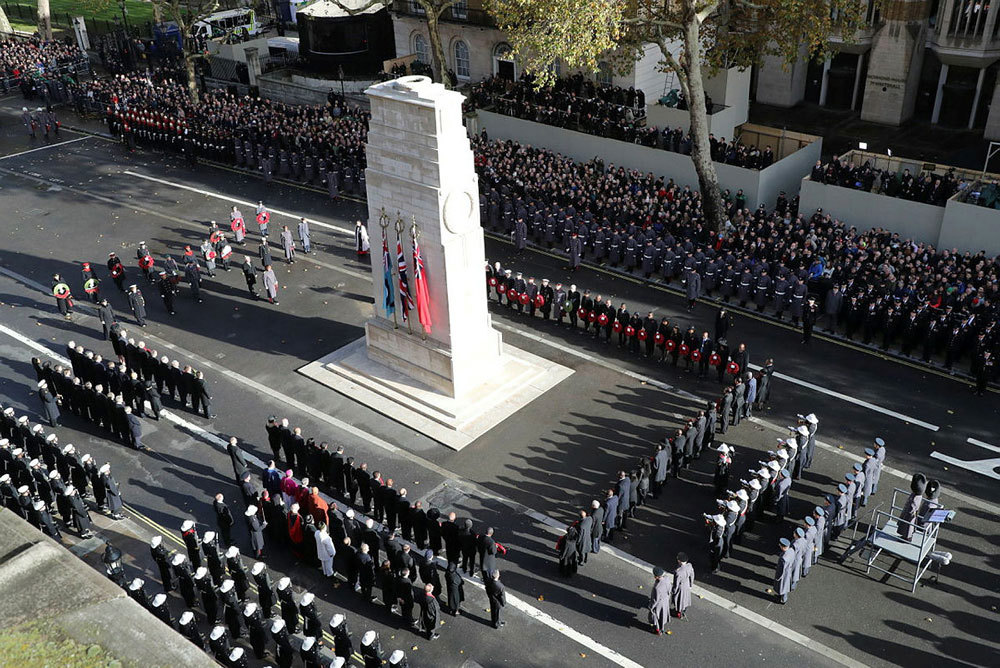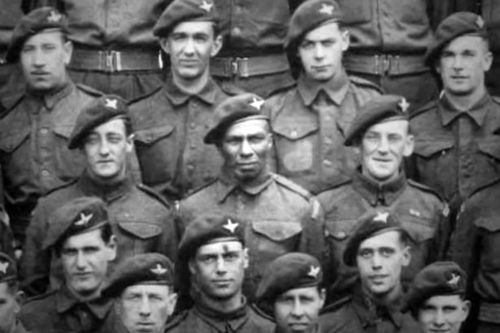08 November 2022
Remembrance Day Soldiers - Stories of the Fallen
Join us as we commemorate the courage and sacrifice of Remembrance Day soldiers this Remembrance season.
Why do we remember soldiers on Remembrance Day?

Poppy wreaths garland a CWGC memorial on Remembrance Day (Unsplash).
Each November, the Commonwealth comes together to recognise, commemorate, and remember the sacrifices of soldiers lost in wars and conflicts around the world.
The traditional date of Remembrance Day is November 11th.
This is the day when, in 1918, the Entente Powers of France and Britain inked The Armistice treaty with Imperial Germany to stop the fighting on the Western Front.
Although technically not the end of the Great War, November 11th is essentially the day the fighting stopped in France and Belgium. Conflict ceased on the Western Front on the 11th Hour of the 11th Day of the 11th Month of 1918.
By the time the gun fell silent, it’s estimated up to 11 million military personnel had been killed. Some counts suggest that as many as 40 million people, including civilians, had been casualties of the War to End All Wars.
The bulk of these men and women were volunteers or conscripts at the time of The Armistice. The professional armies that fought had been ground up by the realities of the world’s first modern war.
The first Remembrance Day was known as Armistice Day and took place on November 11th, 1919. It followed a special dinner hosted by King George V on November 10th.
Since then, it has become an annual tradition that pays homage to the sacrifice of armed forces personnel in conflicts around the world, not just the World Wars.
The Commonwealth War Graves Commission is proudly part of this tradition. See our remembrance roundup from 2021 to see the type of Remembrance Day events and services we take part in.
Is Remembrance Day just for soldiers?
People often forget that soldiers are not the only victims of war.
Families lose their sons and daughters, their brothers, sisters, nieces, nephews, and cousins. Not everyone who falls victim to war has been on the frontlines, served in logistics services, or directly supported the war effort. Civilians are all too often casualties of war too.
That’s why we’re keen to stress the the importance of remembrance at the Commonwealth War Graves Commission.
Since King George V first led Remembrance Day ceremonies in 1919, the event has been expanded to encompass all the victims of wars and conflicts globally, not just the World Wars.
How do we remember fallen soldiers?
 Image: The Cenotaph is the focal point of remembrance in Central London.
Image: The Cenotaph is the focal point of remembrance in Central London.
Remembrance Day soldiers are commemorated in numerous ways around the world. In the United Kingdom, there is a couple of specific ways Remembrance is held.
Remembrance Sunday is the official day of remembrance in the UK. This falls on the Sunday before November 11th if the 11th itself is not a Sunday.
World War Two was behind the change. To logistically hold Remembrance ceremonies during wartime, the Archbishop of Westminster suggested moving the day when ceremonies take place to the Sunday before the 11th as explained above.
The move has also helped reinforce the idea that remembrance is for all those lost in all conflicts, not just World War One.
Services include a sombre, respectful parade undertaken by service personnel across all military branches and wreath-laying ceremonies at the Cenotaph.
The Cenotaph is an enduring stone monument built to replace the original wooden edifice erected during victory parades in 1919.
The Cenotaph was designed by Sir Edwin Lutyens.
Students of the Commission’s history will recognise the name. Sir Edwin Lutyens was one of the CWGC’s principal architects during its early days.
He designed many of our most iconic memorials, including the Thiepval Memorial to the Missing of the Somme, The Merchant Navy Memorial at Tower Hill, and the iconic Stone of Remembrance that sits in all cemeteries holding over 1,000 casualties.
The word “cenotaph” is Greek and means “empty tomb”.
As many of the men who fell in World War One were buried in battlefield cemeteries outside of the UK, the Cenotaph symbolises their absence. It is also a focal point for the mourning of all the Commonwealth’s war dead.
 Image: Poppies are one of the most powerful symbols of remembrance in the UK (Unsplash)
Image: Poppies are one of the most powerful symbols of remembrance in the UK (Unsplash)
In the UK we also wear poppies as a symbol of remembrance.
Poppies were chosen as the bright red flowers grow on the former battlefields of Flanders, Belgium. Here, some of the heaviest fighting of the war took place. The fields of poppies, gently blowing in summer breezes, provide a peaceful contrast to the hellish environs of wartime Flanders.
Canadian Lieutenant-Colonel and war poet John McRae immortalised the flowers in his iconic remembrance poem In Flanders Field’s first stanza:
In Flanders Fields, the poppies blow
Between the crosses, row on row,
That mark our place; and in the sky
The larks, still bravely singing, fly
Scarce heard amid the guns below.
The poppy campaign was started in 1921 by the Royal British Legion and continues to raise money to support veterans every year.
The two-minute silence is another simple yet effective Remembrance Day tradition. On the 11th, workplaces and education centres pause for two minutes of silent contemplation. In that time, we’re invited to once again remember the men and women who gave their lives during both world wars.
At some ceremonies, the start of the two-minute silence is marked by a bugler playing The Last Post.
The Last Post originated in the 1790s when it was played to signify the end of day in military camps after evening inspections had been performed. In the 1850s, the tune’s meaning was changed. Then, if there was no military band available on overseas campaigns, The Last Post was sounded when regimental soldiers had died.
From then on, the tune has gained symbolic meaning representing the end of a soldier’s life, hence why it is now played during Remembrance Day services.
What do soldiers do on Remembrance Day?

Troops parade past the Cenotaph during the annual Remembrance Sunday ceremony (Sgt P.J. George UK MOD © Crown copyright 2021)
One of the key duties for a small section of Remembrance Day soldiers will be attending the Parade at the Cenotaph on Remembrance Sunday. A comparatively low number of troops are involved here.
Soldiers all over the UK will be attending local parades or church services representing the Army in an official capacity. Many will provide security for events and parades up and down the country too, if not taking part.
Commonly, wreaths will be laid at war memorials across the UK. While we look after our own major war memorials at the Commonwealth War Graves Commission, each town and village normally have a smaller monument to the local fallen of both world wars.
Each regiment will also hold its own internal services and events to mark the Armistice. These are not open to the public.
Commonwealth soldiers, such as those in South Africa, Australia, Canada, New Zealand, and India will all hold their own services. They will also take part in any parades and events open to the general public in their respective countries.
Soldier stories
During this remembrance period, we’ve selected a few soldiers’ stories highlighting the sacrifice of the those who fell in the World Wars.
Gunner Alec Rushworth
 Image: Alec Rushworth
Image: Alec Rushworth
Leeds-born Alec Brellisford Rushworth was born in 1897 and enlisted in the British Army in 1915, joining the Royal Field Artillery.
It appears Alec was a brave and dutiful soldier. He was awarded the Military Medal in November 1916, possibly due to his personal bravery during the Somme campaign. However, with no citation surviving, this is just speculation.
It is also possible Alec received his medal posthumously. Gunner Rushworth died from wounds sustained in fighting around Colincamps and Beaumont-Hamel. He was moved to V Corps Main Dressing Station and died from his wounds on 19th November 1916.
Alec had managed to survive the bulk of the six-month battle, but the date of his death tragically fell just one day after the Somme offensive was halted.
He is now buried at Forceville Communal Cemetery.
In April 1916, some two months before the Battle of the Somme began, Alec wrote a letter to his local parish. He was asking for a care package, but Alec’s letter gives us a soldier’s eye view of conditions on the front:
“The life out here is not exactly pleasant, but it is often enlivened by the thoughtfulness of our friends at home […] Our division is still out of action and is just now billeted in the villages just outside a large town. The weather is very changeable just now, but it is nothing like it was during the winter months, when it was sometimes hard to tell whether we had joined the army or the navy.”
Lieutenant Henry Webber
 Image: Lieutenant Henry Webber
Image: Lieutenant Henry Webber
We often think of warfighting as the pursuit of the young, at least the physical, men-on-the-frontline aspects of warfare.
This is not always the case as in the story of Lieutenant Henry Weber.
Henry was born in 1849 and had been working as a stockbroker for over 40 years when World War One broke out in 1914.
Despite volunteering, Henry was turned down for frontline service at the start of the war. This was to be expected, given Henry’s age of 65. Unable to head overseas with the fighting men, Henry instead threw his energies into recruitment and was notable in drumming up service in his local area.
By 1916, the British army had continued to expand. With troops being hurled into costly campaigns around the world, men that had first been rejected from frontline service were reconsidered.
Henry was gazetted into the South Lancashire Regiment as a Temporary Lieutenant on 1st May 1916. He would spend just two months at the front before meeting his end.
While taking rations up to his battalion during the attack on Mametz Wood as part of the Battle of the Somme, Henry was struck in the head by a shell fragment. Sadly, Henry was killed by his injuries and died on the 21st of July 1916.
Henry is the oldest British casualty of the Battle of the Somme, and one of the oldest British casualties of the whole war to be killed on the field of battle. He is buried at Dartmoor Cemetery.
Lieutenant Den Brotherdige
 Image: Lieutenant Den Brotheridge (Wikimedia Commons)
Image: Lieutenant Den Brotheridge (Wikimedia Commons)
We are keen to reiterate the point that Remembrance Day has grown beyond its origins in commemorating and mourning the war dead of the Great War. It incorporates victims of wars and conflicts the world over.
At the Commonwealth War Graves Commission, we look after and tell the stories of casualties from both World Wars. Casualties like Den Brotheridge who served in World War Two.
Den was born in Smethwick, Staffordshire in 1915. He was a noted sportsman, playing for the Aston Villa Colts youth team and cricket team for the Mitchells & Butlers Brewery.
Den was commissioned as a Lieutenant in the Oxfordshire & Buckinghamshire (Ox & Bucks) Light Infantry in July 1942, three years after Britain had declared war on Nazi Germany. He quickly struck up a rapport with his men and was noted as being one of the most well-liked officers in his company.
Lieutenant Brotheridge was chosen to lead 25 Platoon in the Ox & Bucks Light Infantry, as part of D Company. This unit was part of the 6th Airlanding Brigade as part of the 6th Airborne Division as glider troops.
Gliders were wooden-framed, canvas-covered unpowered aircraft. They would be towed by aeroplanes up to a suitable altitude and left to glide silently down to land men on targets as an alternative to paratroopers.
Aircraft of this sort were used for pre-landing operations in the D-Day campaign. Den and his men were involved in such audacious actions, helping capture the now famous Pegasus Bridge over the Caen Canal in Normandy.
Airborne troops, both US and Commonwealth, had orders to capture different strategic objects, such as bridges, prior to the main landings later on the 6th of June.
Some of these objectives, like the capture of Pegasus bridge, were coups de main operations. This involves landing men directly on, or as close as possible to, their intended targets.
At 22.56 in the evening of 5th June, Den and his glider-born troops were towed across the channel and into French airspace. Their glider descended toward their chosen target, landing at 00.16.
Den was assigned to lead the first patrol over the canal and attempt to knock out German machine guns guarding the bridge. The original plan called for Lieutenant David Wood to lead the first platoon over, but this role was reassigned to Den shortly before the Normandy landings.
While Den did make it over Pegasus bridge and knock out an enemy machine-gun pit, Den would not last the battle. Sadly, he was hit in the neck by another machine gun located in a nearby café.
Den died of his wounds in a casualty collection point in a trench between the Caen and Orne canal bridges. It is believed he was the first Allied soldier to die during the Normandy Campaign.
Lieutenant Den Brotheridge is buried in Ranville Churchyard close to Caen.
Pegasus bridge has become an exemplar of a glider-led coup de main style operation and has gone down in folklore. The airborne troops managed to hold the bridge before being relieved by advancing Allied troops later on the 6th of June 1944.
Remembrance Day - black soldiers and their sacrifice
Black soldiers made a significant contribution to both World Wars. Often, they served in logistical and support roles as well as on the frontlines. Whatever their roles, Remembrance Day is a time we reflect on black soldiers’ sacrifices on battlefields around the world.
Here are a couple of interesting stories remembering black soldiers who gave their lives during the World Wars.
Sergeant Sidney Cornell
 Image: Sidney Cornell, centre, with the men of B Company 7th Parachute Battalion (© Pegasus Journal/Solent News)
Image: Sidney Cornell, centre, with the men of B Company 7th Parachute Battalion (© Pegasus Journal/Solent News)
Born in Portsmouth to an African American father and British mother, Sergeant Sidney Cornell served as a paratrooper in airborne operations of World War Two.
Sidney fought in two of the most important airborne actions of the war: Operation Overlord in Normandy as part of the D-Day landings and Operation Varsity in March 1945.
As part of B Company, 7th (Light Infantry) Parachute Battalion, Sidney’s first taste of action came on June 5th, 1944.
Along with thousands of other US and Commonwealth paratroopers, Sidney and his unit were dropped into Normandy. Their task was to capture key objectives, like bridges and transport nodes, to prepare the way for the invasion force landing on June 6th.
Across the next five or so weeks of the Normandy campaign, Sidney served with bravery and distinction. He earned the Distinguished Service Medal (DCM) for his exploits.
Part of his DCM citation, as written by Sidney’s commanding officer, reads: “His courage and many wounds have made him a well-known and admired character throughout not only his own battalion but also the whole brigade. Space does not permit a record of all his feats as he distinguished himself in practically every action and fighting took place daily.
“He is a truly magnificent parachutist, and I cannot recommend him too strongly for a decoration."
By the time of Operation Varsity, Sidney had earned promotion to sergeant.
Operation Varsity is still the largest single landing of airborne soldiers at one site on one day in history. Over 16,000 paratroopers were dropped over the Rhine into Germany as the spearhead for the Allied invasion.
It was during the Allied advance into Germany that Sidney would lose his life.
The 7th Parachute Battalion was coming up on the city of Neustadt and tasked to capture an important bridge outside the metropolis. The bridge, protected by a German garrison, had been rigged to blow.
Sidney and his men had to get across, knock out the defenders, and stop the span from being destroyed so reinforcements could pass and enter Neustadt.
While some members of his platoon did manage to cross the bridge, the explosives were detonated. Sidney lost his life in the ensuing explosion as the bridge came down underneath his feet.
A well-liked, brave, and courageous soldier, Sidney Cornell was initially buried close to where he fell. He is buried in Becklingen War Cemetery, Germany.
Second Lieutenant George Edward Kingsley Bemand
 Image: George Bemand
Image: George Bemand
George Edward Kingsley Bemand was born in 1892 to a British father and a Jamaican mother in Jamaica. His family moved to England in 1908 and travelled there aboard the infamous Lusitania liner.
George, known for being a “cheery soul, always inclined for a joke” attended Dulwich College before moving to University College London to study engineering. When the Great War broke out in July 1914, George spent the Autumn at the University of London Officer Training Corps. He was eventually commissioned as a Second Lieutenant in the Royal Field Artillery – one of the first biracial men to earn a commission in the British Army.
George was posted to France in 1915. During his time at the front, he would serve in an ammunition column during the carnage of the Battle of the Somme.
This was a dangerous, unforgiving job. However, with the British army firing over a million shells a week at the height of the Somme offensive, it was a necessary one. One officer described George’s work as “dangerous and lonely, though extremely important”.
George would earn praise for his courage under fire, moving ammunition up to the gunners at the front.
BY November 1916, the Battle of the Somme was over. Casualties had been immense on both sides. George, like many of the men in his unit, was looking forward to some Christmas time leave in December. This wasn’t to come.
There would be no Christmas Truce like 1914. Instead, fighting would continue to rage across the Western Front.
George was killed by gunfire from German artillery counter-batteries responding to a British attack.
George’s mother Minnie received a telegram informing her of her son’s death on the 30th of December. In the message, George’s CO wrote: “Your son 2nd Lieut. G.E.K. Bemand was serving under me in this battery & he was in action yesterday when a German shell got a direct hit on the dugout in which he and one of my Corporals were sheltering.
“Both your son and the Corporal were killed immediately I am very sorry to say. Will you please accept the very deepest sympathy of the whole battery, officers, and men?
“He was a fine fellow and a brave and fearless soldier, always most cool and exemplary under fire. My best officer, I feel his loss very much.”
George is buried in Le Touret Military Cemetery.
Remembrance Day - Indian soldiers and their stories
Indian troops could be found in some of the World Wars’ fiercest campaigns. They were an ever-present sight on European, Asian, and African battlefields. Here are a couple of Indian soldiers and their experiences to reflect on during this period of remembrance.
Risaldar Badlu Singh VC
 Image: An illustration of Badlu Singh (Wikimedia Commons)
Image: An illustration of Badlu Singh (Wikimedia Commons)
Badlu Singh was born in Jhajjar, Haryana in northern India in 1876.
Badlu was serving as a Risaldar, equivalent to a captain in the British Army, in the 14th Murray’s Jats, British Indian Army, when war broke out in 1914. He is most famous for being posthumously awarded the Victoria Cross (VC) for actions undertaken at Khes Samariveh, Jordan River, Palestine, in September 1918.
His VC citation, published in the 27th November 1918 edition of the London Gazette, reads: “His Majesty the King has been graciously pleased to approve of the award of the Victoria Cross to the undermentioned Officer:
“Ressaidar [sic] Badlu Singh, late 14th Lancers, attached 29th Lancers, Indian Army.
“For most conspicuous bravery and self-sacrifice on the morning of the 23rd September 1918, when his squadron charged a strong enemy position on the west bank of the River Jordan, between the river and Kh. es [sic] Samariveh Village.
“On nearing the position Ressaidar [sic] Badlu Singh realised that the squadron was suffering casualties from a small hill on the left front occupied by machine guns and 200 infantry. Without the slightest hesitation, he collected six other ranks and with the greatest dash and an entire disregard of danger charged and captured the position, thereby saving very heavy casualties to the squadron. He was mortally wounded on the very top of the hill when capturing one of the machine guns single-handed, but all the machine guns and infantry had surrendered to him before he died.
“His valour and initiative were of the highest order.”
Badlu is commemorated on the Heliopolis (Port Tewfik) Memorial alongside over 3,700 other Indian Army troopers that have no known grave.
Subedar Subramanian
 Image: Subedar Subramanian
Image: Subedar Subramanian
Born in the village of Keezha Ottivakkam, near Kanchipuram on 18th December 1912, Subedar Subramanian was already been a military man prior to the outbreak of World War Two.
He had enlisted in the Queen Victoria’s Own Madras Sappers and Miners on 15th October 1932.
This unit formed part of the Indian Army Engineer Solider Corps. Part of its duties was the clear ways through minefields to create safe passage for their comrades. Subedar was undertaking this role in Miganio, Italy, when he earned fame but tragically lost his life.
Miganio is around ten miles south of Cassino, the town that has earned infamy as the site of one of the toughest battles the Allies fought in Italy during World War Two.
On 24th February 1944, Subedar and his team were working their way through a minefield, sweeping the way with mine detectors. They were busy clearing and marking a clear pathway through the potentially deadly ground when one of Subedar’s colleagues accidentally stood a mine being marked.
Subedar through himself on the mine seconds away from detonating without hesitation, using his body to shield his comrades from the blast.
Of course, Subedar did not survive but gave his life so that his friends and team members might live.
For his gallantry, Subedar was awarded the George Cross, becoming the first Indian serviceman to be awarded the medal.
Subedar’s remains were recovered by his teammates. He was then cremated in accordance with this faith.
Today, Subedar is commemorated on the Sangro River Cremation Memorial.
Have your own story to share? Tell us the story of a fallen loved one on our commemorative resource, Evermore.
Discover more stories of Remembrance
We commemorate 1.7 million men and women from around the Commonwealth in our cemeteries and war memorials.
We look after men from the Royal Navy, British Army, and many more Commonwealth forces.
Discover their stories with our Find War Dead tool..
You can also learn more about our sites around the world using our Find Memorials and Cemeteries tool.
What stories of Royal Navy Remembrance will you uncover?

